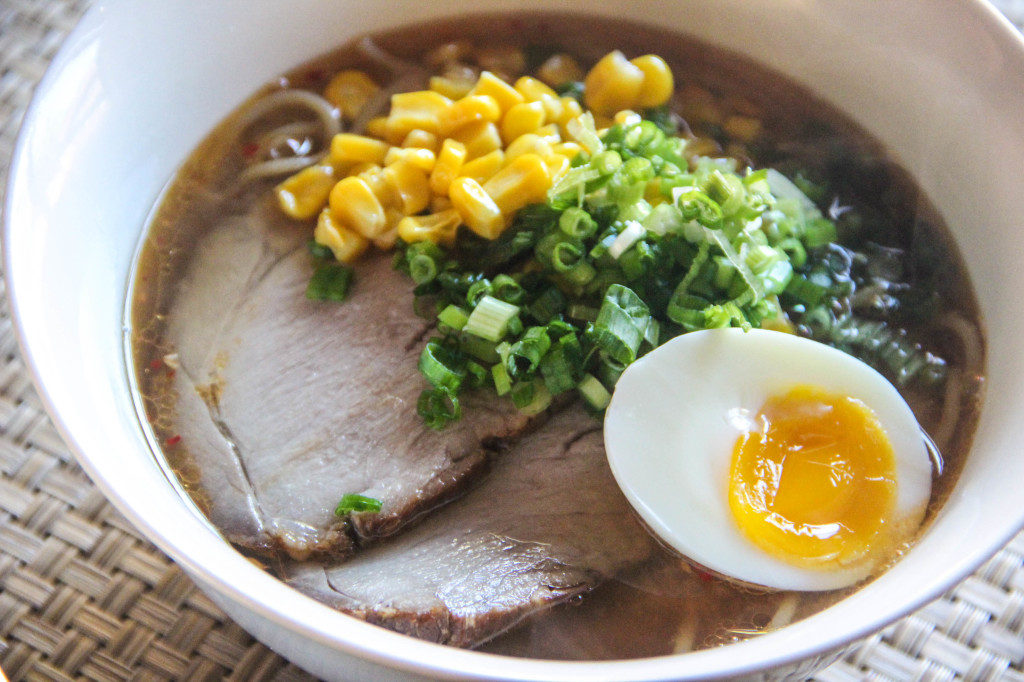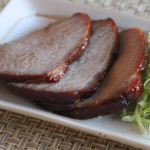Miso Ramen (味噌ラーメン) is Ramen noodles in a Miso based soup that was created in Japan in the 1960s. Ramen noodles are originally Chinese style noodles, but it’s been changed and improved over the years, and evolved to be our own food. And Miso Ramen is the pinnacle of “Japanese” Ramen noodles, the king of all Ramen.
There are millions of Ramen restaurants in Japan, from mom and pop Chinese restaurants in neighborhoods, Ramen street carts open late at night, to sophisticated Ramen specialty shops in cities. People don’t mind lining up for hours to get in as long as it’s good. Fresh noodles are the best, but another form of Ramen that is very popular is instant noodles. It’s become a whole food sub-culture in Japan. There are many many kinds you can buy at supermarkets. Some are even so good that they taste better than bad Ramen shops.
There are two main components in Ramen: noodles and soup. The noodles are called Chinese style noodles (Chuka-men-中華麺), but these are really nothing like Chinese noodles anymore. They are wheat noodles with a firm and chewy texture. The texture is very important because the noodles are in hot soup while eating and might absorb too much soup and become too soft. Unfortunately, it is very hard to find good noodles outside Japan. We tested many kinds you can find in the US, but dried American Chuka-men you can buy at grocery stores are not so great. If you can find dried Chuka-men from Japan, or fresh Chuka-men, use that. We tried dried “thin” spaghetti (a little thinner than regular spaghetti) for our noodles this time instead of the fresh angel hair pasta used in our other Ramen recipe. We think that the texture of dried pasta is much firmer than fresh angel hair pasta. Whichever you use, the key is to boil the noodles in water with baking soda because that gives the noodles a distinct Ramen noodle flavor.
The other half of Ramen is the soup. Generally speaking, there are three basic types of Ramen soups: Shyoyu (soy sauce), Miso, and Shio (salt). Usually pork, chicken or seafood broth is used for the base of the soup, and that is then seasoned with soy sauce, miso, or salt. Here we used ground pork to make a soup base that is very easy and quick. And a very important ingredient for Miso Ramen: Miso Paste! It should be not white nor red Miso, but Awase (mixed) Miso. Also, usually Miso Ramen is a little spicy. You can use any kind of chili paste, but we used Tobanjan (Doubanjiang) Chinise chili paste made from fermented soy beans.
If you like our Ramen Recipe and want some variety, try this! You’ll like it!
Miso Ramen Recipe
Ingredients
Soup
A
- 6 cups water
- 2 cloves garlic (crushed)
- 20 g ginger (sliced)
- 1/2 lb ground pork
- 3-4 green onions
- 3 8x3cm Dried Kombu
B
- 5-6 Tbsp Miso Paste
- 2 Tbsp Sake
- 1 Tbsp Soy Sauce
- 1/2 tsp sugar
- 1/4 tsp chili bean paste such as Tobanjan or any chili paste
C
- 2 Tbsp sesame oil
- 1 clove garlic (grated)
Noodles
- 10 oz dried thin spaghetti
- 8 cups water ( )
- 2 Tbsp baking soda
Topping
- Yakibuta (roast pork)
- soft boiled egg halves
- green onions (cut finely)
- corn (pan-fried with butter and salt)
Instructions
- Prepare the toppings (sliced Yakibuta, boiled eggs, green onions, and cooked corn), before making the soup and noodles. Once the noodles are cooked, you will need to add the soup and toppings right away or the noodles will get soft, so you won’t have time to prepare the toppings at the end.
- Put Ingredients A in a large pot and let boil for 15 minutes. Strain, then put the broth back in the pot.
- Add ingredients B to the broth and let it simmer at low heat.
- In boiling water in a pot, add baking soda (be careful, it may boil over), then add pasta. Cook the pasta according to the package.
- While cooking pasta, add ingredients C to the soup and stir.
- After cooking pasta, immediately divide noodles into bowls and add soup onto noodles. Top with Yakibuta, boiled egg halves, green onions and corns.



15 Comments
Hi there!
I just wanted you to know that i just made your Miso Ramen and the Spicy Shoyu ramen tonight and it was by far THE BEST bowl of ramen i have tasted outside of Japan and all over the USA! My husband and i scarfed them down and i immediately wanted to go send you a donation as a thank you for all that you do! I have been cooking Japanese food for a year now and i find your videos sooo helpful, more helpful than any book (and i have many;) that i have bought on Japanese cooking. Please keep doing what you do and if you ever made a cookbook please know that i will definitely add it to my collection. We have been to Japan 3 times and plan to return again next year, but now that i know i can get a truly authentic bowl of miso ramen at home it will make the wait until we retun just a little easier.
-Amanda Linton-
and P.S. the tip on angel hair pasta is so brilliant! really does make it taste like the REAL THING!
Amanda,
glad you enjoyed our Miso Ramen Recipe! Keep cooking Japanese food!
Just made the miso ramen. It was sooo bad! I went back to the instructions and realized I used triple the amount of kombu that was listed. It had a really fishy taste. I’ll have to try it again one day -properly.
Taffi,
it was too bad you didn’t like your Miso Ramen. Better luck next time!
Please, pretty please, make a book !!! I can’t find simple yet traditional recipes like yours anywhere else.
Thank you for the recipe and the links for some of the ingredients. They were very helpful in helping me find them at the Asian grocery store! I’m a guy, I hardly cook but these instructions` let me get over my fear of prepping and cooking. I thank you and my wife thanks you….
Ramel,
glad we can help. My husband actually use our website too 🙂
Just finished making (and eating of course!) the miso ramen – absolutely delicious!
We visited Tokyo a few years ago and I am always missing the noodle bowls you can find so easily in Japan.
I made this soup yesterday with the Yakibuta. I was so impressed with the flavor of the meat – the marinade is amazing. I wish that there was a recommended internal temperature for the finished temp on the meat as my cut ended up being bigger than 2 pounds. A roast would be done at 145-160 but a pulled meat would be in the 180-200 range and with the cut I had, I wasn’t sure which it was.
The broth for this soup is AMAZING and life changing! It’s so tasty, with lots of complexity. My only complaint about this recipe is that I did not like the baking soda approach to the noodles. I hated the flavor. Next time, I’ll just use the fresh Yaki Soba noodles.
Hi noriko 🙂
Do you have any alternative for pork and sake that used in this recipe? Thank you.
My partner doesnt eat pork..if i used chicken mine instead would i need to change the recipe in any way?
Vi,
chicken will work great too.
Hi, I have been looking all over for a simple ramen soup recipe! Thank you for this. I just wondered if there was anything you could do with the ground pork that you start the soup base with? Seems a shame to throw it away once it’s been strained out.
Dear Noriko and Yuko,
I tried this recipe about 3 weeks ago, and I have made it 4 times since! It’s so tasty and so easy to make. My boyfriend loves it too, and he is a tough croud. lol
For my soup I used dark Miso instead, because that’s the one I had at home at the time. Also I used chopped pork which I marinated over night in soysauce, honey, ginger and garlic.
As toppings I added shredded fresh spinach. Fantastic taste.
Thank you so much for the recipe, you two are amazing!
Greetings from Germany